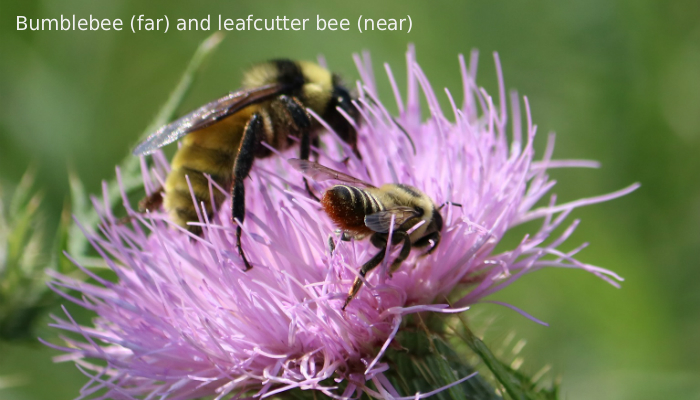The Bee in Winter

When you think of bees in winter, perhaps you imagine the well-known scene of a colony of non-native honeybees: a boxy wooden hive painted white housing a humming cluster of workers surrounding their queen.
But that is just one strategy; the many species of native bees found along the Greenway employ a variety of techniques for ensuring their offspring can carry on through our harsh, bitterly cold winter months.
Leafcutter bees (Megachile sp.) build nests in hollows and holes above ground. A female will chew circles out of leaves or petals, which she will carry to her chosen tube and use to line individual chambers. She will provision each chamber with a supply of pollen and nectar, and lay a single egg per chamber. This egg may hatch prior to winter, but the larva remains in the chamber, devouring the pollen and developing into a prepupa, as which it spends the winter before completing its development and emerging as an adult in the summer.
Agapostemon sp., including metallic green sweat bees, will normally nest in the ground. The female will excavate a tunnel and lay a single egg in each of several branches within the tunnel. The eggs are laid and hatched within a single summer (sometimes two generations per summer); females will mate at the end of the season and sequester themselves underground, waiting until the following spring to emerge and lay their eggs. Males will, alas, die at the end of the season.
In contrast to these mostly solitary species, bumblebees (Bombus sp.) are social and will form more complex colonies surrounding a single queen. A queen bumblebee will spend the winter underground after mating (again, the unfortunate males will die before winter). When she emerges in the spring she will scout a nest site and provision it with pollen before laying eggs together in a single batch, which she will care for as they develop into a generation of workers.
The queen bumblebee will continue laying eggs throughout the summer, with the earlier generation of workers helping take over foraging and caring for their younger siblings. At the end of the season the queen will lay eggs that will develop into males, who will find and mate with queens from other colonies, and new queens, which will be responsible for overwintering after mating and founding new colonies the following year. When the temperature drops, the remaining workers in the original colony will die, along with the founding queen.
Originally published in Sycamore Greenway Friends


